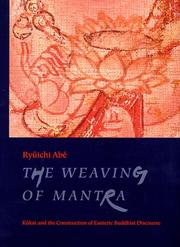| Listing 1 - 1 of 1 |
Sort by
|

ISBN: 0231112866 0231112874 9780231112864 9780231112871 Year: 1999 Publisher: New York: Columbia university press,
Abstract | Keywords | Export | Availability | Bookmark
 Loading...
Loading...Choose an application
- Reference Manager
- EndNote
- RefWorks (Direct export to RefWorks)
"The Buddhist priest Kukai (774-835) is credited with the introduction and formal establishment of tantric - or esoteric - Buddhism in early ninth-century Japan and the founding of the Shingon school. In The Weaving of Mantra, author Ryuichi Abe examines this important religious figure and his profound influence on Japanese culture. Abe contends that the importance of Kukai's establishment of esoteric Buddhism lay not in the foundation of the Shingon sect but in his creation of a general theory of language grounded in the ritual speech of mantra." "The Weaving of Mantra embeds Kukai within the fabric of political and social life in ninth-century Japan and explains how esoteric Buddhism played a critical role in many societal changes in Japan - from the growth of monasteries into major feudal powers to the formation of the native phonetic alphabet, kana. As Abe illustrates, Kukai's writings and the new type of discourse they spawned also marked Japan's transition from the ancient order to the medieval world, replacing Confucianism as the ideology of the state."--BOOK JACKET.
Shingon (Sect) --- Doctrines. --- Esoterik. --- Mantra. --- Sectes bouddhiques --- Shingon (secte). --- Kūkai, --- Kūkai. --- Studies. --- Japon --- Religion --- J1876 --- J1800.30 --- Japan: Religion -- Buddhism -- Shingon --- Japan: Religion -- Buddhism -- history -- Heian period (794-1185) --- Shingon-Schule --- Kūkai, --- Kūkai --- 774-835 --- Doctrines
| Listing 1 - 1 of 1 |
Sort by
|

 Search
Search Feedback
Feedback About UniCat
About UniCat  Help
Help News
News